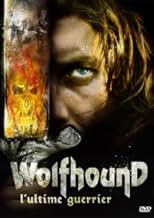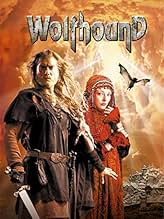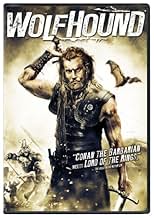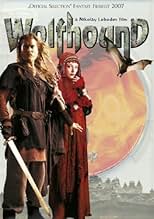PUNTUACIÓN EN IMDb
5,6/10
4,3 mil
TU PUNTUACIÓN
Fue condenado a morir, pero logró sobrevivir, y ahora su misión es vengarse de la aniquilación de su tribu.Fue condenado a morir, pero logró sobrevivir, y ahora su misión es vengarse de la aniquilación de su tribu.Fue condenado a morir, pero logró sobrevivir, y ahora su misión es vengarse de la aniquilación de su tribu.
- Dirección
- Guión
- Reparto principal
- Premios
- 2 premios y 9 nominaciones en total
Eugenia Tudorascu
- Khaygal
- (as Evgeniya Todorashko)
Anatoliy Beliy
- Vinitar
- (as Anatoliy Belyy)
Juozas Budraitis
- Dungorm
- (as Yuozas Budraytis)
Reseñas destacadas
5ssto
please don't compare it to Lord of the Rings. i see many of the commentators here do it, but its totally wrong. LOTR put the limit too high for any fantasy movie, its the gold standard now in the industry, and hardly any movie can reach its heights, i hope this doesn't mean that people will stop making this kind of movies. but they shouldn't create crap either. I didn't like Volkodav very much and i was irritated many times while i watched it. The dialog is so simplistic, the story is...i would say the writers made it along the way while shooting the movie - what ever something happens each of the main characters just calls for the help of some god that we never know the story of their relationship with. Naturally the gods always help our heroes. I haven't read the book and maybe if i had many of the gaps would've been filled, but LOTR did fine filling any gaps for the people who haven't read the books...Ooops - I compared Volkodav with LOTR...:)
the movie is not badly made, has some nice effects and thats basically it...
the movie is not badly made, has some nice effects and thats basically it...
Coming from someone who has no prior knowledge of the book and who loves Russian fantasy, Wolfhound was a film with good things as well as a lot of problems. The way that Wolfhound looks is its best asset, the scenery is just breathtaking, the costumes really suit the fantasy atmosphere and most of the photography- excepting some slow-motion that doesn't add anything- and CGI are similarly great(loved the bat). Second place is the music score, which is hauntingly beautiful and adds so much to every scene. The atmosphere is brilliantly evocative as well, and there is some good acting in the supporting cast, Nina Usatova knows how to steal a scene and it is thrilling to watch. The leads are not as convincing, there is a fair bit of awkwardness and the wild-eyed innocence does go overboard. Most of the action scenes are chaotic, especially the climax. The direction is inconsistent, sometimes it's fluid and assured, at other times it gets chaotic and convoluted like in the action scenes. The script is rather stilted and doesn't give the actors much to work with or give us time to properly get to know the characters(basically left as fantasy clichés), while the story is formulaic(much has been said about the Conan the Barbarian-like beginning and understandably), very daft at times and not always very engaging. There's a lot of atmosphere here but not enough magic and the structure can feel choppy and rushed, you don't have to have read the book to figure out that there were things left out and re-written, it actually shows. In conclusion, a fantasy film that induced mixed results from this viewer, some good things on display(the production values and music) but there's too much bad too(story, script and action scenes). 5/10 Bethany Cox
I've just seen this glorious epic at a Kiev cinema and am amazed at how Russian cinema can release such a superb fantasy film. This is an adaptation of the first Volkodav fantasy novel by Maria Semyonova that draws on a wide range of Slavic mythology.
Alexander Bukharov is well cast as the hero, the "wolfhound" fighting the evil "wolf", with a strong supporting cast that relies on impact more than the hairstyles, tooth-whitener and revealing loincloths of Hollywood. This is not a sentimental film, but accepts the violence and closeness-to-nature of tribal life, reminiscent of the Dark Ages. The film's stark, realistic feel reminded me of Mel Gibson's Apocalypto, that emotionally draws many parallels.
Bukharov would be an ideal King Arthur or King Alfred - it's a pity that his nationality will probably write off any Hollywood offers. The obvious comparison is to Lord of the Rings, but the movie manages to keep originality in many plot strands, effects and characterization's.
Its landscapes are relatively muted, having been filmed in Slovakia rather than New Zealand, but its effects and monsters are winners over Hollywood, by maintaining suspense and keeping many nasties just out of vision. By having the main effects based on primal forces of nature, rather than a new-generation iteration of Predator or Alien, it avoids the typical clichés that most fantasy films suffer from.
I hope this gets a wide release in Europe and the USA - it certainly deserves it.
Alexander Bukharov is well cast as the hero, the "wolfhound" fighting the evil "wolf", with a strong supporting cast that relies on impact more than the hairstyles, tooth-whitener and revealing loincloths of Hollywood. This is not a sentimental film, but accepts the violence and closeness-to-nature of tribal life, reminiscent of the Dark Ages. The film's stark, realistic feel reminded me of Mel Gibson's Apocalypto, that emotionally draws many parallels.
Bukharov would be an ideal King Arthur or King Alfred - it's a pity that his nationality will probably write off any Hollywood offers. The obvious comparison is to Lord of the Rings, but the movie manages to keep originality in many plot strands, effects and characterization's.
Its landscapes are relatively muted, having been filmed in Slovakia rather than New Zealand, but its effects and monsters are winners over Hollywood, by maintaining suspense and keeping many nasties just out of vision. By having the main effects based on primal forces of nature, rather than a new-generation iteration of Predator or Alien, it avoids the typical clichés that most fantasy films suffer from.
I hope this gets a wide release in Europe and the USA - it certainly deserves it.
Not surprisingly, the new wave of Russian directors & films kick some asses, for sure. For the ones who haven't seen "Admiral", "Mongol" or "The 9th Company", "Wolfhound" might be quite a nice surprise. This movie is very well made, full of high tension fighting scenes and quite a nice plot (slightly touched by clichés like LOTR or Conan, of course). No, it's not Peter Jackson, no Hollywood sky-high budgeted movie: it'a a nice movie from Russia. I think we'll hear about Mr. Ledbedev (the director) quite soon. Anyway, this is only the first book from the four ones on the subject,right? What it's more interesting is that, even the leading lady-actress starred in "The Bourne Supremacy", the rest of the cast is quite new to us. And they don't disappoint, if you just don't make the big mistake to compare them to the Hollywood stars, living in a different system with different rules. Before 1989, living in Romania, I was intoxicated with Russian movies (the war ones, quite good, the classics - exceptional, but some of them were really crap), maybe more than other people behind the Iron Curtain. Now, it's good to see there is a new fresh breath in the Russian movie-making.
Russia's first proper foray into Tolkeinesque fantasy cinema, WOLFHOUND, based on the first novel of a tetralogy by Maria Semyonova about a last-of-his-tribe mighty warrior, is a mixed bag on the one hand, it is formulaic, derivative and uneven in terms of acting and pacing; on the other, there is enough novelty in the film's distinctly Slavic demeanor, philosophical subtext and production design to make it play well internationally as a crossover curio.
WOLFHOUND opens with the back-story of the main character, a mighty warrior from the Grey Hound tribe named Wolfhound (Bukharov). While still only a child, Wolfhound's family is killed by marauders led by the evil priest Zhadoba and his henchman the Man-Eater (Domogarov). Zhadoba steals a sword forged by Wolfhound's father and has Wolfhound enslaved. The boy grows up dreaming of revenge.
Zhadoba is priest of Morana, a malevolent goddess that has been imprisoned by spell cast by the rulers of Galirad, one of whom, Princess Helen (Akinshina) is betrothed to the Man-Eater's son Vinitar (Bely) in an effort to keep the peace. Zhadoba is trying to free Morana to wreak havoc upon the world and subsequently dominate. He hopes to accomplish this by spilling the blood of Helen at the ancient shrine where Morana is imprisoned. Standing between him and his goal is Wolfhound, who, after saving Helen from an assassination attempt in Galirad, becomes her bodyguard.
Contrary to many Russians' fatalistic attitudes towards life, the film presents a new and intriguing philosophical slant in terms of the free will versus determinism debate, which comes out in favor of free will. Wolfhound frees himself from slavery by killing one of his captors, thereby changing his fate. As a free man, he pursues revenge, but throughout the film, his conscience, in the form of visions of a female spirit, comes to question whether the seemingly fated cycle of killing is worth continuing when he encounters Vinitar, the last of his enemies, in battle.
If the plot sounds formulaic and derivative, it is. Intentionally or not, the opening sequence is virtually a remake of John Milius's CONAN THE BARBARIAN. Masked in a sharp-toothed skull helmet, Zhadoba is vaguely reminiscent of Tolkein's dark lord Sauron. The predictability of the storyline and the pace, which lags in places, sometimes makes you wish they'd just get on with it. In terms of editing, the film could have been better served with a classic, chronological progression of the main character's life rather than its more trendy, non-linear, flashback tack, which dampens its philosophical message.
The performances are uneven, with the supporting cast generally better than the leads. TV heartthrob Bukharov (Russian TV series MAROSEIKA 12) and internationally known Oksana Akinshina (LILJA4EVER, THE BOURNE SUPREMACY) look appropriately wide-eyed in the right places, neither of them leaves much of an impression. The purported love story between them feels pat due to being underdeveloped plot-wise. Since this is Russia's first LOTR-style fantasy and the genre is very alien to Russian cinema, some sequences feel downright awkward in terms of acting. Also a bit gawky is the very noticeable use of facial close-ups, presumably in order for the film to subsequently play well on the small screen.
One of the more memorable performances was that of the matronly Nina Usatova as the leader of the savage Kharyuk people, whose lands Helen's entourage has to cross to reach her betrothed. Usatova steals every scene in that sequence, which is somewhat obviously played for comic relief.
Nevertheless, the film acquits itself well by stretching its comparatively shoestring budget to the limit. It looks similar to a $40 $50 million Hollywood film. The cinematography is atmospheric, well lit and generally melds well with the computer-generated effects. CGI use is rather sparing compared with something like LOTR, but then this is not only because of budgetary constraints. The filmmakers didn't cut corners on things like extras and sets. The film features around 1800 costumed extras, and nine different "large" sets were built, the most spectacular of these being Galirad, which covered 5 kilometers square on a Mosfilm studio backlot. The film also makes use of numerous on-location forest sequences shot in Slovakia. CGI is used mostly in the background in establishing shots and the level of CGI use builds up slowly, until going full-bore in the closing magical battle sequence. The battle scenes of are varying quality some are quite clear and easy to follow, while others are pretty sloppy and a blur of swords and grunts. The fighting is not very gory and would probably earn the film a PG-13 rating in the U.S.
The film's unique and exotic look, which draws on an amalgam of some never-before-seen elements from Slavic archeology, makes it a novelty item. Wolfhound looks positively Scythian with his long hair, beard, scars and animal-hide costume. Helen's red beaded wedding dress was painstakingly created from 3000 individual parts. The bat sidekick is a first, and its CGI is very accomplished nearly impossible to tell that the bat was not real. A healing process used by a white wizard to remedy some near-fatal wounds is also thus far one-of-kind. It uses heat provided from the campfires and the three healing sequences (one of them repairing the bat's wing) elicit a sense of wonder.
Outside of Russia, the film should benefit from the post-Lord-of-the-Rings renewed interest in the fantasy genre and the general curiosity about Russians' take on the genre.
WOLFHOUND opens with the back-story of the main character, a mighty warrior from the Grey Hound tribe named Wolfhound (Bukharov). While still only a child, Wolfhound's family is killed by marauders led by the evil priest Zhadoba and his henchman the Man-Eater (Domogarov). Zhadoba steals a sword forged by Wolfhound's father and has Wolfhound enslaved. The boy grows up dreaming of revenge.
Zhadoba is priest of Morana, a malevolent goddess that has been imprisoned by spell cast by the rulers of Galirad, one of whom, Princess Helen (Akinshina) is betrothed to the Man-Eater's son Vinitar (Bely) in an effort to keep the peace. Zhadoba is trying to free Morana to wreak havoc upon the world and subsequently dominate. He hopes to accomplish this by spilling the blood of Helen at the ancient shrine where Morana is imprisoned. Standing between him and his goal is Wolfhound, who, after saving Helen from an assassination attempt in Galirad, becomes her bodyguard.
Contrary to many Russians' fatalistic attitudes towards life, the film presents a new and intriguing philosophical slant in terms of the free will versus determinism debate, which comes out in favor of free will. Wolfhound frees himself from slavery by killing one of his captors, thereby changing his fate. As a free man, he pursues revenge, but throughout the film, his conscience, in the form of visions of a female spirit, comes to question whether the seemingly fated cycle of killing is worth continuing when he encounters Vinitar, the last of his enemies, in battle.
If the plot sounds formulaic and derivative, it is. Intentionally or not, the opening sequence is virtually a remake of John Milius's CONAN THE BARBARIAN. Masked in a sharp-toothed skull helmet, Zhadoba is vaguely reminiscent of Tolkein's dark lord Sauron. The predictability of the storyline and the pace, which lags in places, sometimes makes you wish they'd just get on with it. In terms of editing, the film could have been better served with a classic, chronological progression of the main character's life rather than its more trendy, non-linear, flashback tack, which dampens its philosophical message.
The performances are uneven, with the supporting cast generally better than the leads. TV heartthrob Bukharov (Russian TV series MAROSEIKA 12) and internationally known Oksana Akinshina (LILJA4EVER, THE BOURNE SUPREMACY) look appropriately wide-eyed in the right places, neither of them leaves much of an impression. The purported love story between them feels pat due to being underdeveloped plot-wise. Since this is Russia's first LOTR-style fantasy and the genre is very alien to Russian cinema, some sequences feel downright awkward in terms of acting. Also a bit gawky is the very noticeable use of facial close-ups, presumably in order for the film to subsequently play well on the small screen.
One of the more memorable performances was that of the matronly Nina Usatova as the leader of the savage Kharyuk people, whose lands Helen's entourage has to cross to reach her betrothed. Usatova steals every scene in that sequence, which is somewhat obviously played for comic relief.
Nevertheless, the film acquits itself well by stretching its comparatively shoestring budget to the limit. It looks similar to a $40 $50 million Hollywood film. The cinematography is atmospheric, well lit and generally melds well with the computer-generated effects. CGI use is rather sparing compared with something like LOTR, but then this is not only because of budgetary constraints. The filmmakers didn't cut corners on things like extras and sets. The film features around 1800 costumed extras, and nine different "large" sets were built, the most spectacular of these being Galirad, which covered 5 kilometers square on a Mosfilm studio backlot. The film also makes use of numerous on-location forest sequences shot in Slovakia. CGI is used mostly in the background in establishing shots and the level of CGI use builds up slowly, until going full-bore in the closing magical battle sequence. The battle scenes of are varying quality some are quite clear and easy to follow, while others are pretty sloppy and a blur of swords and grunts. The fighting is not very gory and would probably earn the film a PG-13 rating in the U.S.
The film's unique and exotic look, which draws on an amalgam of some never-before-seen elements from Slavic archeology, makes it a novelty item. Wolfhound looks positively Scythian with his long hair, beard, scars and animal-hide costume. Helen's red beaded wedding dress was painstakingly created from 3000 individual parts. The bat sidekick is a first, and its CGI is very accomplished nearly impossible to tell that the bat was not real. A healing process used by a white wizard to remedy some near-fatal wounds is also thus far one-of-kind. It uses heat provided from the campfires and the three healing sequences (one of them repairing the bat's wing) elicit a sense of wonder.
Outside of Russia, the film should benefit from the post-Lord-of-the-Rings renewed interest in the fantasy genre and the general curiosity about Russians' take on the genre.
¿Sabías que...?
- CuriosidadesSecond place big budget for any post-Soviet Russian film.
- ConexionesEdited into Gothic: Der geheimnisvolle Händler (2012)
- Banda sonoraWolfhound - Slaves Song (OST version)
Selecciones populares
Inicia sesión para calificar y añadir a tu lista para recibir recomendaciones personalizadas
- How long is Wolfhound?Con tecnología de Alexa
Detalles
- Fecha de lanzamiento
- País de origen
- Sitios oficiales
- Idioma
- Títulos en diferentes países
- Wolfhound, el guerrer
- Localizaciones del rodaje
- Empresa productora
- Ver más compañías en los créditos en IMDbPro
Taquilla
- Presupuesto
- 20.000.000 US$ (estimación)
- Recaudación en todo el mundo
- 21.573.338 US$
- Duración2 horas 22 minutos
- Color
- Mezcla de sonido
- Relación de aspecto
- 2.35 : 1
Contribuir a esta página
Sugerir un cambio o añadir el contenido que falta

Principal laguna de datos
What is the English language plot outline for Wolfhound, el guerrero (2006)?
Responde
























